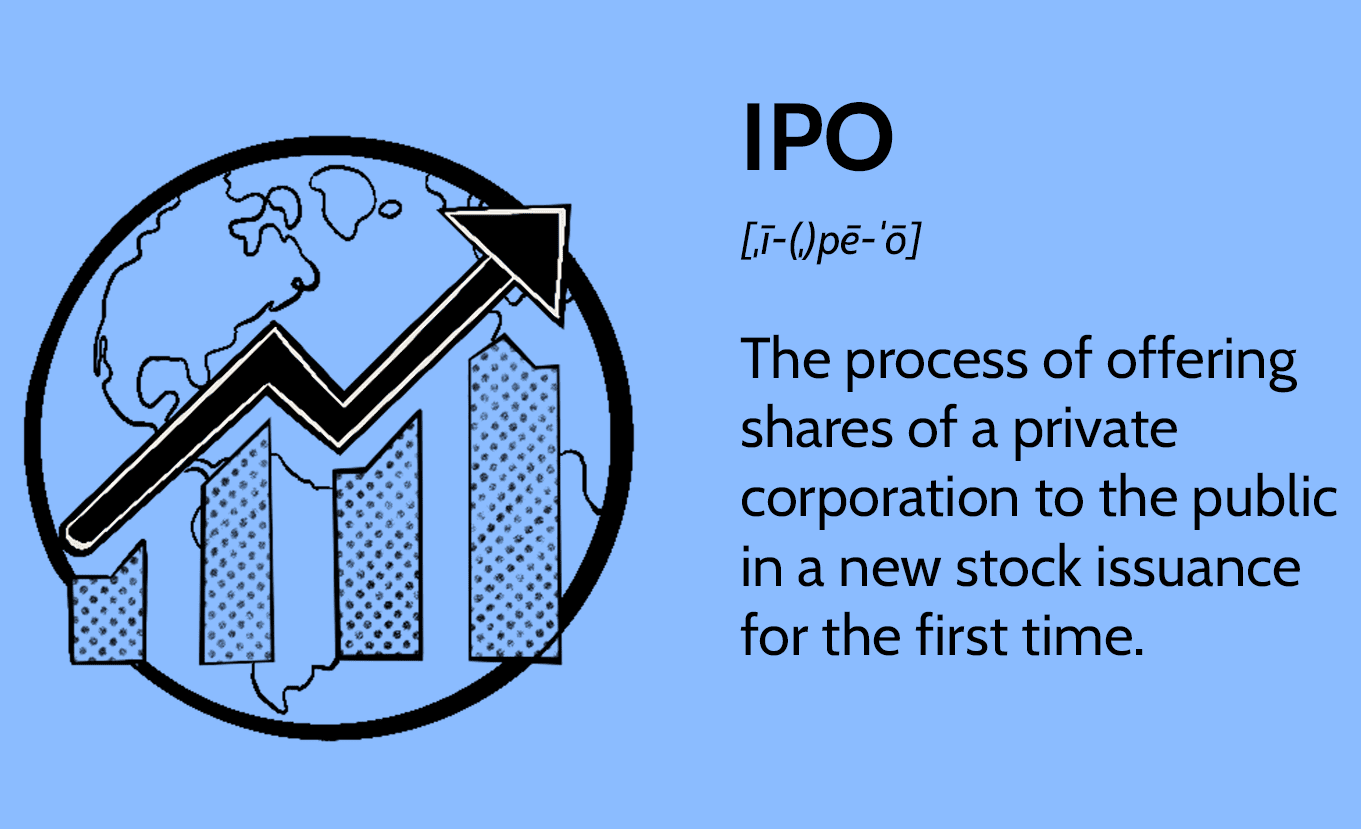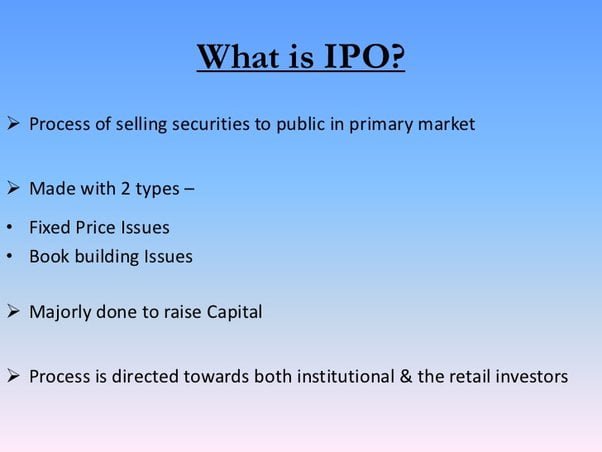What is an IPO – Initial public offering? An Initial public offering (Initial public offering) alludes to the most common way of offering portions of a confidential company to general society in another stock issuance. An Initial public offering permits an organization to raise value capital from public financial backers.
The change from a private to a public organization can be a significant time for private financial backers to completely acknowledge gains from their speculation as it commonly incorporates an offer premium for current confidential financial backers. In the meantime, it additionally permits public financial backers to partake in the contribution.
What is an IPO – Initial public offering? and KEY Focal points
An Initial public offering (IPO) alludes to the most common way of offering portions of a confidential enterprise to people in general in another stock issuance.

Organizations should meet prerequisites by trades and the Protections and Trade Commission (SEC) to hold an Initial public offering.
Initial public offerings give organizations a chance to get capital by offering shares through the essential market.
Organizations employ speculation banks to advertise, check interest, and set the Initial public offering cost and date, and that’s only the tip of the iceberg.
An Initial public offering should be visible as a leave technique for the organization’s pioneers and early financial backers, to understand the full benefit from their confidential venture.

How an Initial Public Offering (IPO) Works
Before an Initial public offering, an organization is viewed as private. As a pre-Initial public offering privately owned business, the business has developed with a moderately modest number of investors including early financial backers like the pioneers, family, and companions alongside proficient financial backers like investors or private supporters.
An Initial public offering is a major step for an organization as it furnishes the organization with admittance to collect a large chunk of change. This enables the organization to develop and grow. The expanded straightforwardness and offer posting validity can likewise be a figure assisting it with getting better terms while looking for acquired assets too.
At the point when an organization arrives at a phase in its development cycle where it accepts it is experienced enough for the afflictions of SEC guidelines alongside the advantages and obligations to public investors, it will start to promote its revenue in opening up to the world.
Normally, this phase of development will happen when an organization has arrived at a confidential valuation of roughly $1 billion, otherwise called unicorn status. Notwithstanding, privately owned businesses at different valuations with solid basics and demonstrated productivity potential can likewise fit the bill for an Initial public offering, contingent upon the market rivalry and their capacity to meet posting necessities.
Initial public offering portions of an organization are estimated through endorsing an expected level of effort. At the point when an organization opens up to the world, the recently possessed private offer proprietorship converts to public proprietorship, and the current confidential investors’ portions become worth the public exchange cost. Share endorsing can likewise incorporate unique arrangements for private to public offer proprietorship.

For the most part, the progress from private to public is a vital time for private financial backers to trade out and procure the profits they were anticipating. Confidential investors might clutch their portions in the public market or sell a part or every one of them for gains.
In the meantime, the public market opens up a gigantic chance for a large number of financial backers to purchase partakes in the organization and contribute money to an organization’s investors’ value. The public comprises anybody with any interest in putting resources into the organization.
By and large, the quantity of offers the organization sells and the cost for what offers sell are the creating factors for the organization’s new investors’ value esteem. Investors’ value actually addresses shares claimed by financial backers when it is both private and public, however with an Initial public offering, the investors’ value increments fundamentally with cash from the essential issuance.
History of Initial Public Offerings
The term Initial public offering (IPO) has been a trendy expression on Money Road and among financial backers for a really long time. The Dutch are credited with directing the main current Initial public offering by offering portions of the Dutch East India Organization to the overall population.
From that point forward, Initial public offerings have been utilized as a way for organizations to raise capital from public financial backers through the issuance of public offer proprietorship.
As the years progressed, Initial public offerings have been known for upswings and downtrends in issuance. Individual areas likewise experience upswings and downtrends in issuance because of advancement and other monetary variables. Tech Initial public offerings duplicated at the level of the dotcom blast as new companies without incomes hurried to show themselves on the financial exchange.
The 2008 monetary emergency brought about a year with the most number of Initial public offerings. After the downturn following the 2008 monetary emergency, Initial public offerings came to a standstill, and for certain years later, new postings were uncommon. All the more as of late, a significant part of the Initial public offering buzz has moved to an emphasis on purported unicorns — new businesses that have arrived at private valuations of more than $1 billion. Financial backers and the media intensely guess about these organizations and their choice to open up to the world by means of an Initial public offering or remain private.
What Is the Initial Public Offering Interaction?
The Initial public offering process basically comprises two sections. The first is the pre-showcasing period of the contribution, while the second is the first sale of the stock itself. At the point when an organization is keen on an Initial public offering, it will promote to financiers by requesting private offers or it can likewise offer a public expression to create interest.
The guarantors lead the Initial public offering process and are picked by the organization. An organization might pick one or a few guarantors to oversee various pieces of the Initial public offering process cooperatively. The guarantors are engaged with each part of the Initial public offering a reasonable level of effort, record readiness, documenting, showcasing, and issuance.
Moves toward an Initial public offering
Recommendations. Guarantors present propositions and valuations examining their administrations, the best sort of safety to issue, offering value, measure of offers, and assessed time period for the market offering.
Guarantor. The organization picks its guarantors and officially consents to guarantee terms through an endorsing arrangement.
Group. Initial public offering groups are framed involving financiers, legal advisors, affirmed public bookkeepers (CPAs), and Protections and Trade Commission (SEC) specialists.
Documentation. Data in regards to the organization is ordered for required Initial public offering documentation. The S-1 Enrollment Explanation is the essential Initial public offering recording archive. It has two sections — the outline and the secretly held recording information.1 The S-1 incorporates fundamental data about the normal date of the filing.2 It will be reexamined frequently all through the pre-initial public offering process. The included outline is likewise modified consistently.
Advertising and Updates. Advertising materials are made for pre-promoting of the new stock issuance. Guarantors and leaders market the offer issuance to gauge interest and lay out a last contribution cost. Guarantors can make corrections to their monetary examination all through the promoting system. This can incorporate changing the Initial public offering cost or issuance date as they see fit. Organizations do whatever it takes to meet explicit public offer contribution necessities. Organizations should stick to both trade posting prerequisites and SEC necessities for public organizations.
Board and Cycles. Structure a top managerial staff and guarantee processes for detailing auditable monetary and bookkeeping data each quarter.
Shares Gave. The organization gives its portions on an Initial public offering date. Capital from the essential issuance to investors is gotten as money and recorded as investors’ value on the accounting report. Accordingly, the accounting report’s share esteem becomes reliant upon the organization’s investors’ value per share valuation thoroughly.
Post Initial public offering. Some post-initial public offering arrangements might be initiated. Financiers might make some predetermined memories edge to purchase an extra measure of offers after the Initial public offering (Initial public offering) date. In the interim, certain financial backers might be liable to calm periods.
Benefits and Weaknesses of an Initial Public Offering
The essential goal of an Initial public offering is to raise capital for a business. It can accompany different benefits as well as impediments.
Benefits
One of the key benefits is that the organization gains admittance to speculation from the whole financial planning public to raise capital. This works with more straightforward securing bargains (share transformations) and builds the organization’s openness, distinction, and public picture, which can help the organization’s deals and benefits.
Expanded straightforwardness that accompanies required quarterly revealing can typically assist an organization with getting more positive credit terms than a privately owned business.
Disservices
Organizations might face a few burdens in opening up to the world and possibly pick elective systems. A portion of the significant disservices incorporates the way that Initial public offerings are costly, and the expenses of keeping a public organization are continuous and generally irrelevant to different expenses of carrying on with work.
Changes in an organization’s portion cost can be an interruption for the executives, which might be redressed and assessed in light of stock execution as opposed to truly monetary outcomes. Furthermore, the organization becomes expected to uncover monetary, bookkeeping, charge, and other business data. During these exposures, it might need to freely uncover mysteries and business techniques that could be useful to contenders.
Inflexible initiative and administration by the governing body can make it more hard to hold great chiefs able to face challenges. Staying private is dependably a choice. Rather than opening up to the world, organizations may likewise request offers for a buyout. Also, there can be a few choices that organizations might investigate.
Experts
Can bring extra subsidizes up later on through auxiliary contributions
Draws in and holds better administration and talented representatives through fluid stock value cooperation (e.g., ESOPs)
Initial public offerings can give an organization a lower cost of capital for both value and obligation
Cons
Huge legitimate, bookkeeping and advertising costs emerge, a large number of which are continuous
Expanded time, exertion, and consideration expected of the executives for announcing
There is a deficiency of control and more grounded organizational issues
Initial public offering Change
